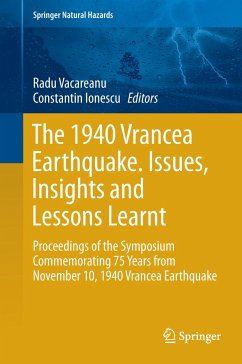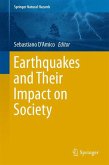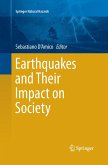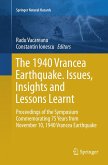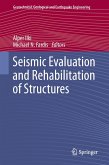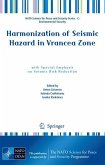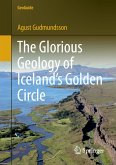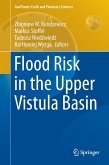The 1940 Vrancea Earthquake. Issues, Insights and Lessons Learnt
Proceedings of the Symposium Commemorating 75 Years from November 10, 1940 Vrancea Earthquake
Herausgegeben:Vacareanu, Radu; Ionescu, Constantin
The 1940 Vrancea Earthquake. Issues, Insights and Lessons Learnt
Proceedings of the Symposium Commemorating 75 Years from November 10, 1940 Vrancea Earthquake
Herausgegeben:Vacareanu, Radu; Ionescu, Constantin
- Gebundenes Buch
- Merkliste
- Auf die Merkliste
- Bewerten Bewerten
- Teilen
- Produkt teilen
- Produkterinnerung
- Produkterinnerung
These proceedings include most of the available information on this major seismic event and its consequences. With an estimated moment magnitude of 7.7 and a heavy toll in terms of human and economic losses, it ranks as the largest intermediate-depth earthquake in Europe in the twentieth century. Nevertheless, because of the difficult conditions in the 1940s, the lessons learnt after the Vrancea earthquake were not extensively shared with the international scientific community and thus, this book fills a gap in the literature discussing the knowledge acquired after major disasters.
Past…mehr
Andere Kunden interessierten sich auch für
![Earthquakes and Their Impact on Society Earthquakes and Their Impact on Society]() Earthquakes and Their Impact on Society106,99 €
Earthquakes and Their Impact on Society106,99 €![Earthquakes and Their Impact on Society Earthquakes and Their Impact on Society]() Earthquakes and Their Impact on Society76,99 €
Earthquakes and Their Impact on Society76,99 €![The 1940 Vrancea Earthquake. Issues, Insights and Lessons Learnt The 1940 Vrancea Earthquake. Issues, Insights and Lessons Learnt]() The 1940 Vrancea Earthquake. Issues, Insights and Lessons Learnt149,99 €
The 1940 Vrancea Earthquake. Issues, Insights and Lessons Learnt149,99 €![Seismic Evaluation and Rehabilitation of Structures Seismic Evaluation and Rehabilitation of Structures]() Seismic Evaluation and Rehabilitation of Structures112,99 €
Seismic Evaluation and Rehabilitation of Structures112,99 €![Harmonization of Seismic Hazard in Vrancea Zone Harmonization of Seismic Hazard in Vrancea Zone]() Anton Zaicenco / Iolanda Craifaleanu / Ivanka Paskaleva (eds.)Harmonization of Seismic Hazard in Vrancea Zone75,99 €
Anton Zaicenco / Iolanda Craifaleanu / Ivanka Paskaleva (eds.)Harmonization of Seismic Hazard in Vrancea Zone75,99 €![The Glorious Geology of Iceland's Golden Circle The Glorious Geology of Iceland's Golden Circle]() Agust GudmundssonThe Glorious Geology of Iceland's Golden Circle30,99 €
Agust GudmundssonThe Glorious Geology of Iceland's Golden Circle30,99 €![Flood Risk in the Upper Vistula Basin Flood Risk in the Upper Vistula Basin]() Flood Risk in the Upper Vistula Basin75,99 €
Flood Risk in the Upper Vistula Basin75,99 €-
-
-
These proceedings include most of the available information on this major seismic event and its consequences. With an estimated moment magnitude of 7.7 and a heavy toll in terms of human and economic losses, it ranks as the largest intermediate-depth earthquake in Europe in the twentieth century. Nevertheless, because of the difficult conditions in the 1940s, the lessons learnt after the Vrancea earthquake were not extensively shared with the international scientific community and thus, this book fills a gap in the literature discussing the knowledge acquired after major disasters.
Past experience together with current understanding of the 1940 Vrancea earthquake are presented along with the latest information on Romanian seismicity, seismic hazard and risk assessment, and seismic evaluation and rehabilitation of buildings and structures. Moreover, it includes excerpts from Romanian post-disaster reports and textbooks concerning the earthquake.
Past experience together with current understanding of the 1940 Vrancea earthquake are presented along with the latest information on Romanian seismicity, seismic hazard and risk assessment, and seismic evaluation and rehabilitation of buildings and structures. Moreover, it includes excerpts from Romanian post-disaster reports and textbooks concerning the earthquake.
Produktdetails
- Produktdetails
- Springer Natural Hazards
- Verlag: Springer / Springer International Publishing / Springer, Berlin
- Artikelnr. des Verlages: 978-3-319-29843-6
- 1st ed. 2016
- Seitenzahl: 536
- Erscheinungstermin: 3. März 2016
- Englisch
- Abmessung: 241mm x 160mm x 35mm
- Gewicht: 962g
- ISBN-13: 9783319298436
- ISBN-10: 3319298437
- Artikelnr.: 44431216
- Herstellerkennzeichnung
- Springer-Verlag GmbH
- Tiergartenstr. 17
- 69121 Heidelberg
- ProductSafety@springernature.com
- Springer Natural Hazards
- Verlag: Springer / Springer International Publishing / Springer, Berlin
- Artikelnr. des Verlages: 978-3-319-29843-6
- 1st ed. 2016
- Seitenzahl: 536
- Erscheinungstermin: 3. März 2016
- Englisch
- Abmessung: 241mm x 160mm x 35mm
- Gewicht: 962g
- ISBN-13: 9783319298436
- ISBN-10: 3319298437
- Artikelnr.: 44431216
- Herstellerkennzeichnung
- Springer-Verlag GmbH
- Tiergartenstr. 17
- 69121 Heidelberg
- ProductSafety@springernature.com
Part 1. Effects and lessons from November 10th, 1940 Vrancea earthquake.- Overview of Part 1.- The strong Romanian earthquakes of 10.11.1940 and 4.03.1977. Lessons learned and forgotten?.- Before and after November 10th, 1940 earthquake.- The collapse of Carlton building in Bucharest at November 10, 1940 earthquake: an analysis based on recovered images.- Main characteristics of November 10, 1940 strong Vrancea earthquake in seismological and physics of earthquake terms.- The 10 November 1940 - The first moment of truth for modern constructions in Romania.- Macroseismic effect of the November 10, 1940 earthquake in the territory of Moldova, Ukraine and Russia.- Causes and effects of the November 10, 1940 earthquake.- Part 2. Seismicity of Romania. Seismic hazard assessment; local soil conditions effect.- Overview of Part 2.- Use of various discrimination techniques to separate small magnitude events occurred in the northern part of Romania.- Prediction of site characterization based onfield investigations and empirical correlations.- Spectral displacement demands for strong ground motions recorded during Vrancea intermediate-depth earthquakes.- Analysis of the seismic activity in the Vrancea intermediate-depth source region during the period 2010-2015.- A Contemporary View to the Impact of the Strong Vrancea Earthquakes on Bulgaria.- Site dependent seismic hazard assessment for Bucharest based on stochastic simulations.- Scaling properties for the Vrancea subcrustal earthquakes: an overview.- The 2013 earthquake swarm in the Galati area: first results for a seismotectonic interpretation.- Comparison of three major historical earthquakes with three recent earthquakes.- An attempt to bridge the gap between the traditional concept of seismic intensity and the need of accuracy required by engineering activities.- Earthquake precursors assessment in Vrancea region through satellite and in-situ monitoring data.- Part 3. Structural design in seismic areas; performance- based design.- Overview of Part 3.- Influence of the infill panels masonry type on the seismic behaviour of reinforced concrete frame structures.- A time-domain approach for the performance-based analysis of tall buildings in Bucharest.- Unidirectional cyclic behavior of old masonry walls in Romania.- Viscous Damper Distribution using Genetic Algorithms and Pattern Search Optimization.- Selecting and Scaling Strong Ground Motion Records Based on Conditional Mean Spectra. Case Study for Iasi City in Romania.- Part 4. Seismic evaluation and rehabilitation. Seismic risk assessment.- Overview of Part 4.- Estimation of Damage-Loss from Scenario Earthquake Analogous to November 10, 1940 in Republic of Moldova.- Some remarks regarding seismic vulnerability for orthodox churches.- Seismic loss estimates for scenarios of the 1940 Vrancea Earthquake.- Seismic loss estimates for scenarios of the 1940 Vrancea Earthquake.- Rapid Earthquake Early Warning (REWS) in Romania: Application in real time for governmental authority and critical infrastructures.- Seismic assessment and rehabilitation of existing constructions after the 10th November 1940 and 4th March 1977 earthquakes in Romania.- Analytical seismic fragility functions for dual RC structures in Bucharest.- Conceptual framework for the seismic risk evaluation of transportation networks in Romania.- Annex 1.- Annex 2.- Annex 3.
Part 1. Effects and lessons from November 10th, 1940 Vrancea earthquake.- Overview of Part 1.- The strong Romanian earthquakes of 10.11.1940 and 4.03.1977. Lessons learned and forgotten?.- Before and after November 10th, 1940 earthquake.- The collapse of Carlton building in Bucharest at November 10, 1940 earthquake: an analysis based on recovered images.- Main characteristics of November 10, 1940 strong Vrancea earthquake in seismological and physics of earthquake terms.- The 10 November 1940 - The first moment of truth for modern constructions in Romania.- Macroseismic effect of the November 10, 1940 earthquake in the territory of Moldova, Ukraine and Russia.- Causes and effects of the November 10, 1940 earthquake.- Part 2. Seismicity of Romania. Seismic hazard assessment; local soil conditions effect.- Overview of Part 2.- Use of various discrimination techniques to separate small magnitude events occurred in the northern part of Romania.- Prediction of site characterization based onfield investigations and empirical correlations.- Spectral displacement demands for strong ground motions recorded during Vrancea intermediate-depth earthquakes.- Analysis of the seismic activity in the Vrancea intermediate-depth source region during the period 2010-2015.- A Contemporary View to the Impact of the Strong Vrancea Earthquakes on Bulgaria.- Site dependent seismic hazard assessment for Bucharest based on stochastic simulations.- Scaling properties for the Vrancea subcrustal earthquakes: an overview.- The 2013 earthquake swarm in the Galati area: first results for a seismotectonic interpretation.- Comparison of three major historical earthquakes with three recent earthquakes.- An attempt to bridge the gap between the traditional concept of seismic intensity and the need of accuracy required by engineering activities.- Earthquake precursors assessment in Vrancea region through satellite and in-situ monitoring data.- Part 3. Structural design in seismic areas; performance- based design.- Overview of Part 3.- Influence of the infill panels masonry type on the seismic behaviour of reinforced concrete frame structures.- A time-domain approach for the performance-based analysis of tall buildings in Bucharest.- Unidirectional cyclic behavior of old masonry walls in Romania.- Viscous Damper Distribution using Genetic Algorithms and Pattern Search Optimization.- Selecting and Scaling Strong Ground Motion Records Based on Conditional Mean Spectra. Case Study for Iasi City in Romania.- Part 4. Seismic evaluation and rehabilitation. Seismic risk assessment.- Overview of Part 4.- Estimation of Damage-Loss from Scenario Earthquake Analogous to November 10, 1940 in Republic of Moldova.- Some remarks regarding seismic vulnerability for orthodox churches.- Seismic loss estimates for scenarios of the 1940 Vrancea Earthquake.- Seismic loss estimates for scenarios of the 1940 Vrancea Earthquake.- Rapid Earthquake Early Warning (REWS) in Romania: Application in real time for governmental authority and critical infrastructures.- Seismic assessment and rehabilitation of existing constructions after the 10th November 1940 and 4th March 1977 earthquakes in Romania.- Analytical seismic fragility functions for dual RC structures in Bucharest.- Conceptual framework for the seismic risk evaluation of transportation networks in Romania.- Annex 1.- Annex 2.- Annex 3.

